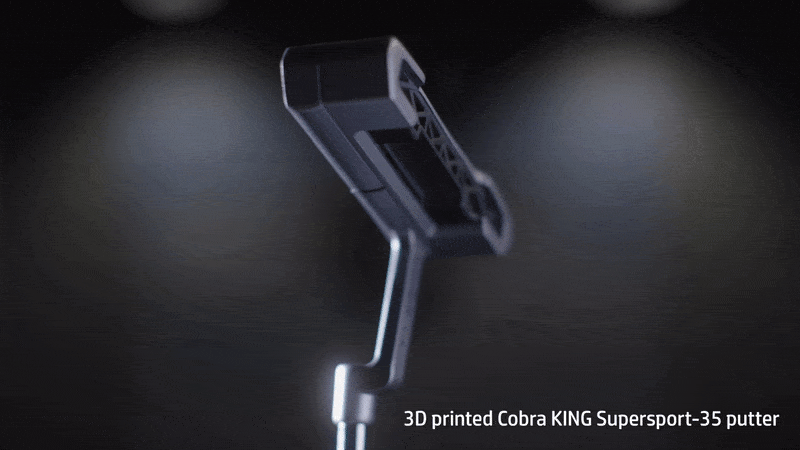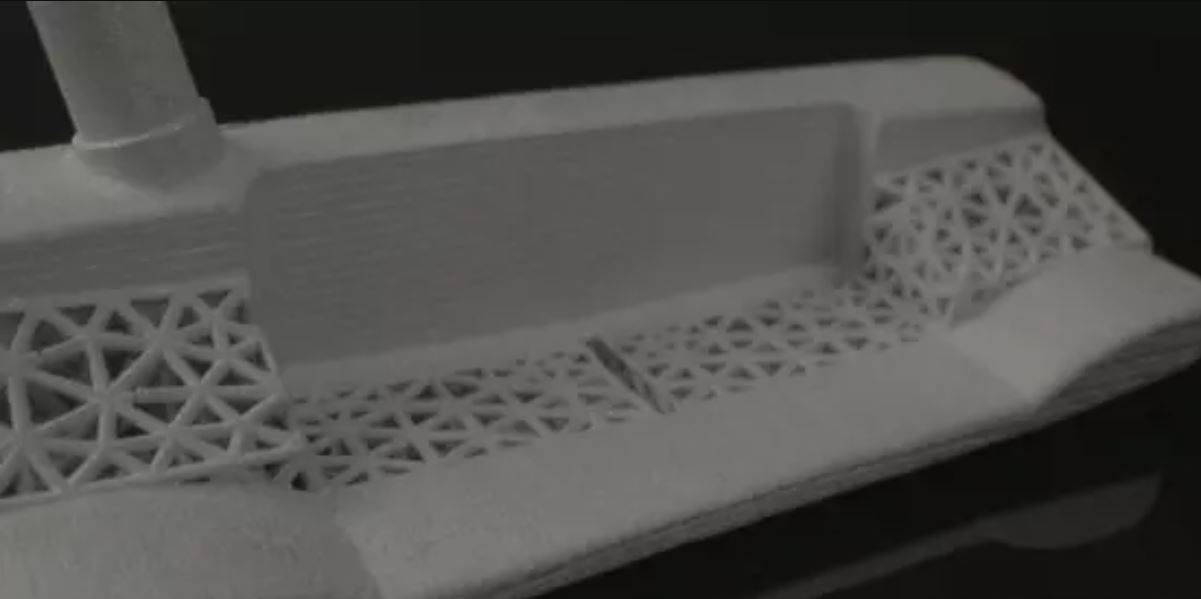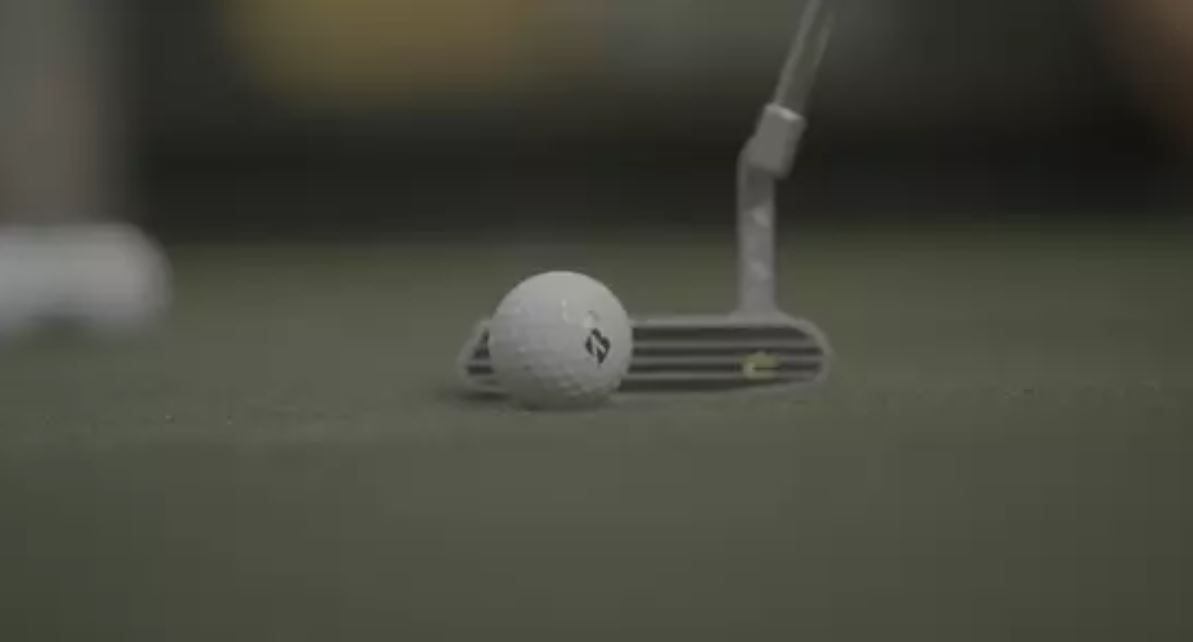A first-of-its-kind 3D printed golf putter, the KING Supersport-35 3DP, has just been commercially launched by Cobra Golf, a leading golf equipment manufacturer, which developed this latest innovation in golf equipment in partnership with HP and Parmatech.
Cobra Golf has a long history of innovation in golf equipment, known for its introduction of hybrid material gold clubs with the Baffler, for lighter clubs featuring graphite shafts, and oversized irons, among other products. The brand currently has leading golf professionals Bryan DeChambeau, Rickie Fowler, and Lexi Thompson using and marketing its equipment at the highest level of the game. In continuing with its focus on innovative products, Cobra began working with HP and Parmatech over the past two years, although they announced the collaboration only later this year. The collaboration was for a strategic, multi-year product roadmap, and the KING Supersport-35 3DP Putter is just the first of several revolutionary commercial Cobra products using 3D printing.
“The power of personalization enabled by 3D printing delivers completely reimagined consumer products and experiences,” said Uday Yadati, global head of HP Metal Jet, HP Inc. “This first of its kind putter is a shining example of the disruptive design and production capabilities of HP Metal Jet 3D printing technology. Cobra’s commitment to innovation and competitive excellence combined with the technical expertise and leadership from Parmatech has led to a breakthrough design win for golf fans around the world.”
The new club has been optimized for weight distribution and moment-of-inertia (MOI, a measure f how much a club head resists twisting on off-center strikes of the ball) to ensure consistency, reliability, and accuracy in every putt. To develop the design, engineers and designers at Cobra, who are also avid golfers, began working in early 2019 with their counterparts at HP and Parmatech, and by early 2020, thirty-five design iterations had been created in a period of eight months.
Their multiple-PGA tour winning ambassador, DeChambeau, also helped in fine-tuning the design. While HP’s Metal Jet technology is expected to be launched in 2021, it had already been selected and applied by Cobra (using 316 stainless steel material for the entire metal body of the club) for the advantages it brought over traditional manufacturing in design adaptability, processing time, optimization and materials. Currently, the innovation has been primarily in optimizing design and weight distribution, but in the future, it could have far broader impacts, including customization at the individual level for golfers, and a shift towards on-demand production, as well as domestic manufacturing for the golf equipment industry.
With the optimized design and lattice structure which can only be manufactured using AM, weight has been distributed away from “residing in the center of a putter’s head out to its toe and heel.” This results in the highest moment of inertia in blade shape, more reliable and repeatable putts—also called ‘forgiveness’ by golfers.
“If you miss hit the putt on the heel or toe, you still want the putt to perform like you hit it on the sweet spot,” says Ryan Roach, senior principal innovation engineer at Cobra Golf.
In addition, the design also features a high-performance aluminum face insert that uses patented Descending Loft Technology from SIK Golf, a putting manufacturer, to create “more consistent launch conditions on strikes across the face,” as per Cobra.
This isn’t the first time 3DPrint.com has reported on the use of 3D printing by Cobra Puma Golf (acquired by Puma in 2010), which the company had already been leveraging the technology for over two decades. In 2015, we’d covered how the firm was relying on it for the rapid prototyping of golf club head designs. At the time, the University of Dundee and St. Andrews Golf Co., had taken a step further in developing as close to end-use parts as possible, with replicated old golf club head designs laser sintered in cobalt chromium.
The application of AM in golf equipment has since grown beyond just R&D or prototyping and as costs have fallen, into production with end-use materials for golf accessories and professional equipment. Golf equipment is also quite suitable for AM applications, as it is comparatively low volume, with consumers willing to pay a premium for high-performance equipment. A set of golf clubs could typically cost between $200-500, with premium equivalents priced as high as $1,000. So, AM is suited well for design and prototyping needs in golf, and now has matured to provide a more efficient production-at-scale solution for the golf industry.
Leading golf brands have partnered with AM solution providers to develop real-world golf clubs with better performance than ever before. The world’s largest golf manufacturer, Callaway Golf Company, partnered with Australia-based Titomic in 2018. TaylorMade teamed up with Formlabs to redevelop irons, putters, wedges and balls. And a few years earlier, Krone Golf worked with CRP Group to redesign and manufacture a metal-composite multi-material club head.
The application of AM in golf clubs is expected though, as, in the U.S., nearly two-thirds of the market for equipment industry sales is tired to clubs, with balls representing the other one-third. We’d also covered how Nike was researching additive manufacturing of an all-new golf ball. Applications have very much moved toward end-products, with better performing, optimal designs that aren’t attainable using traditional manufacturing methods (forging, casting, CNC machining). With properties optimizable at the powder level, metal jet printing allows for light weighting, localized stiffness, and creation of complex structures improving not only performance, but also the feel, sound, and reliability of the club.
Yet to show how far AM has come with regards to golf, when Cobra signed an agreement with HP in June this year, the goal was not just to use AM to redesign a more efficient, better performing golf club but to include HP’s solutions in a transformed digital design-to-production supply chain for a new generation of digitally-made golf equipment.
At Cobra Golf we strive to deliver high-performance products that help golfers of all levels play their best and enjoy the game,” said Jose Miraflor, Vice President of Marketing, Cobra Golf. “To do that, it’s critical to use the most effective manufacturing processes to design, develop, and achieve optimal results, and we’ve certainly done that with this new putter.”
Where before clubs and club heads were manufactured using forging, casting or milling, today the most complex, optimal shapes can be printed at once by spraying 630 million nanogram-sized drops of binding liquid onto a stainless steel powder bed to form the part, layer by layer. A water-based polymer binding liquid is used to bind the metal powder together, and once printed, the powder bed is cured or heated to remove the binder liquid and leave a high-strength, solid, complex metal part.
“Metal Jet allows us to move grain-by-grain, printing metal material exactly where we need it,” says Cameron Day, a principal innovation designer at Cobra Golf and lead architect of the SuperSport-35.
The successful application of HP’s Metal Jet technology doesn’t mean that it will entirely replace traditional manufacturing for golf equipment going forward. Although it is a near net shape part, and printed more precisely than ever before, CNC machining still had to be used as a post-processing step, albeit minimally, to achieve the desired level of detail. Yet it has an impact across the value chain for Cobra Golf: accelerating R&D, product development, manufacturing, and time to market for the golf equipment manufacturer.
“There’s no other way to make this putter, given how it’s designed and attributes this has,” says Mike Yagley, Cobra Golf’s vice president of innovation and AI. “And the cost has come down to the point where we could actually mass produce these. Does the cost of it compete with conventional putter-head manufacturing processes? Not quite yet,” he adds. “But is it practical? Can we manufacture it, provide great performance and afford to sell it? Yes.”
“I’ve had a lot of success over the years with my SIK putter and was really excited to work with Cobra to develop a new way to manufacture equipment and bring this new putter to market,” said DeChambeau. “HP’s Metal Jet technology is an incredibly advanced production method and very exacting, which is pretty critical in golf equipment. I think golfers of all levels will benefit from the combination of COBRA’s high MOI (moment of inertia) design and SIK’s Descending Loft Technology.”
“The dreamy stuff from a consumer standpoint is to make heads specific to the needs of one player,” explains Yagley. “It could be the weight of the head, loft, lie or even center of gravity location.
The King Supersport-35 is now available in limited quantities for $399, shipping from November 20, 2020. Two more products from Cobra Golf, which will also incorporate the advantages of 3D printing technology, will be launched in 2021.
Subscribe to Our Email Newsletter
Stay up-to-date on all the latest news from the 3D printing industry and receive information and offers from third party vendors.
Print Services
Upload your 3D Models and get them printed quickly and efficiently.
You May Also Like
3D Printing News Briefs, July 2, 2025: Copper Alloys, Defense Manufacturing, & More
We’re starting off with metals in today’s 3D Printing News Briefs, as Farsoon has unveiled a large-scale AM solution for copper alloys, and Meltio used its wire-laser metal solution to...
3DPOD 260: John Hart on VulcanForms, MIT, Desktop Metal and More
John Hart is a Professor at MIT; he´s also the director of the Laboratory for Manufacturing and Productivity as well as the director of the Center for Advanced Production Technologies....
3D Printing News Briefs, June 28, 2025: Defense Accelerator, Surgical Models, & More
In this weekend’s 3D Printing News Briefs, 3YOURMIND was selected to join an EU Defense Accelerator, and PTC has announced model-based definition (MBD) capabilities within Onshape. Finally, a study out...
EOS in India: AM’s Rising Star
EOS is doubling down on India. With a growing base of aerospace startups, new government policies, and a massive engineering workforce, India is quickly becoming one of the most important...






































